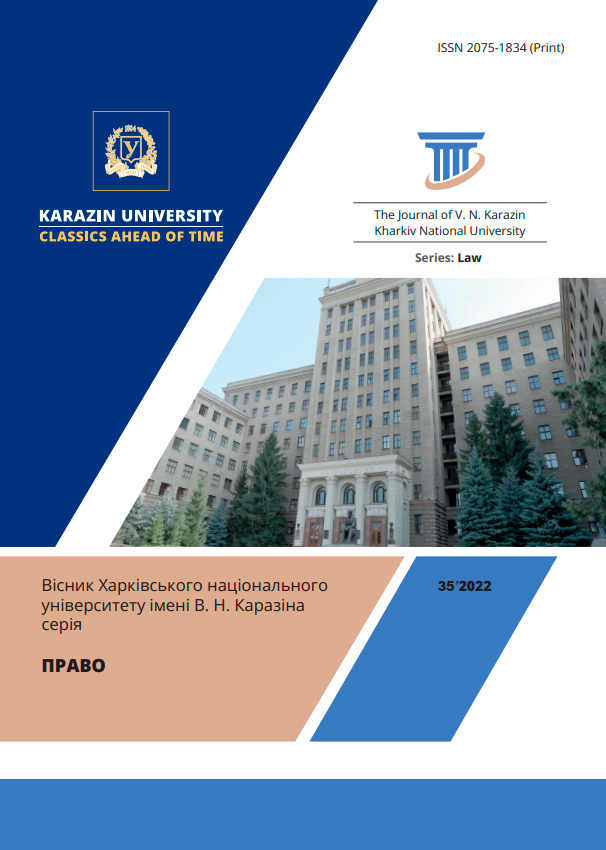The essence and characteristics of paramilitary and armed formations not provided for by law in terms of criminal liability for their creation (Article 260 of the Criminal Code of Ukraine)
Abstract
The article analyzes the essence and characteristics of paramilitary and armed formations not provided for by law in terms of criminal liability for their creation, which is provided for in Article 260 of the Criminal Code of Ukraine. Attention is drawn to the fact that the notes to the article and Article 260 of the Criminal Code of Ukraine do not reveal all the signs of paramilitary and armed formations not provided for by law. So, in particular, note 1 does not indicate signs of illegal paramilitary formations at all. All the above signs are characteristic of paramilitary formations provided for by law. As regards note 2, which refers to armed groups, among the signs that indicate their illegal nature there is only one, namely the illegal possession of usable firearms, explosives or other weapons.
The authors express a position according to which in order to provide a meaningful characterization of paramilitary and armed formations not provided for by law, it is necessary to start from the features of military and paramilitary formations provided for by law, which exist in the doctrine of military law. Based on this, the essential features of paramilitary and armed formations not provided for by law include the following: 1) not provided for, not regulated by law or directly prohibited by it; 2) are not included in the mechanism of the Ukrainian state; 3) have their own relatively stable internal military-type structure with the division of duties, as well as the presence of those structures (persons) that manage them; 4) cannot be staffed by military personnel; 5) combat and mobilization readiness, as well as combat capabilities, must be constantly carried out; 6) has a special (paramilitary) nature of military-service relations and methods of activity; 7) goals and objectives are formulated by the persons who create them and manage them; 8) they are not entrusted at the official level with tasks related to the defense of Ukraine, the protection of its sovereignty, state independence and national interests; 9) they may be suitable for the actual conduct of military (combat) operations; 10) paramilitary formations cannot carry weapons, and for armed formations such a sign is mandatory; 11) are organized and function on the basis of unity; 12 subordination; 13) a discipline that has a large number of common features with military discipline; 14) military or military or physical training is carried out.
Downloads
References
/References
Кримінальний Кодекс України від 5 квітня 2001 р. № 2341-III. Відомості Верховної Ради України. 2001. № 25-26. Ст. 131
Богуцький В. В., Григоренко Є. І. Юридична відповідальність у системі військового управління (теоретико-управлінський аспект) : монографія / В. В. Богуцький, Є. І. Григоренко. Харків : Юрайт, 2022. 180 с.
Кримінальний кодекс України : наук.-практ. комент. : у 2 т. / за заг. ред. В. Я. Тація, В. П. Пшонки, В. І. Борисова, В. І. Тютюгіна. 5-те вид., доповн. Харків : Право, 2013. Т. 2 : Особлива частина. 492 с.
Вознюк А. А. Створення не передбачених законом воєнізованих або збройних формувань: актуальні проблеми кримінальної відповідальності. Актуальні проблеми застосування кримінального законодавства : матеріали круглого столу (Київ, 5 листоп. 2015 р.). Київ : Ін-т кримін.-виконав. служби, 2015. С. 46.
Конончук А. О. Кримінально-правова характеристика створення не передбачених законом воєнізованих або збройних формувань та участі в них : дис... докт. філософ. : 081 / Національна академія внутрішніх справ. Київ, 2021. 197 c.
Науково-практичний коментар Кримінального кодексу України / [А. М. Бойко, Л. П. Брич, В. К. Грищук та ін.] ; за ред. М. І. Мельника, М. І. Хавронюка. 9-те вид., переробл. та доповн. Київ : Юрид. Думка, 2012. 825 c.
Кримінальний кодекс України : наук.-практ. комент. : у 2 т. / за заг. ред. В. Я. Тація, В. П. Пшонки, В. І. Борисова, В. І. Тютюгіна. 5-те вид., доповн. Харків : Право, 2013. Т. 2 : Особлива частина. 535 c.
Робак В. А. Кримінальна відповідальність за створення не передбачених законом воєнізованих або збройних формувань : дис. … канд. юрид. наук : 12.00.08. Київ, 2008. 188 c.
Kryminalnyi Kodeks Ukrainy vid 5 kvitnia 2001 r. № 2341-III. Vidomosti Verkhovnoi Rady Ukrainy. 2001. № 25-26. St. 131. (in Ukrainian)
Bohutskyi V. V., Hryhorenko Ye. I. Yurydychna vidpovidalnist u systemi viiskovoho upravlinnia (teoretyko-upravlinskyi aspekt) : monohrafiia / V. V. Bohutskyi, Ye. I. Hryhorenko. Kharkiv : Yurait, 2022. 180 s. (in Ukrainian)
Kryminalnyi kodeks Ukrainy : nauk.-prakt. koment. : u 2 t. / za zah. red. V. Ya. Tatsiia, V. P. Pshonky, V. I. Borysova, V. I. Tiutiuhina. 5-te vyd., dopovn. Kharkiv : Pravo, 2013. T. 2 : Osoblyva chastyna. 492 s. (in Ukrainian)
Vozniuk A. A. Stvorennia ne peredbachenykh zakonom voienizovanykh abo zbroinykh formuvan: aktualni problemy kryminalnoi vidpovidalnosti. Aktualni problemy zastosuvannia kryminalnoho zakonodavstva : materialy kruhloho stolu (Kyiv, 5 lystop. 2015 r.). Kyiv : In-t krymin.-vykonav. sluzhby, 2015. S. 46. (in Ukrainian)
Kononchuk A. O. Kryminalno-pravova kharakterystyka stvorennia ne peredbachenykh zakonom voienizovanykh abo zbroinykh formuvan ta uchasti v nykh : dys... dokt. filosof. : 081 / Natsionalna akademiia vnutrishnikh sprav. Kyiv, 2021. 197 c. (in Ukrainian)
Naukovo-praktychnyi komentar Kryminalnoho kodeksu Ukrainy / [A. M. Boiko, L. P. Brych, V. K. Hryshchuk ta in.] ; za red. M. I. Melnyka, M. I. Khavroniuka. 9-te vyd., pererobl. ta dopovn. Kyiv : Yuryd. Dumka, 2012. 825 c. (in Ukrainian)
Kryminalnyi kodeks Ukrainy : nauk.-prakt. koment. : u 2 t. / za zah. red. V. Ya. Tatsiia, V. P. Pshonky, V. I. Borysova, V. I. Tiutiuhina. 5-te vyd., dopovn. Kharkiv : Pravo, 2013. T. 2 : Osoblyva chastyna. 535 c. (in Ukrainian
Robak V. A. Kryminalna vidpovidalnist za stvorennia ne peredbachenykh zakonom voienizovanykh abo zbroinykh formuvan : dys. … kand. yuryd. nauk : 12.00.08. Kyiv, 2008. 188 c. (in Ukrainian)
Copyright (c) 2023 Євген Григоренко, Олександр Передерій, Михайло Чалий

This work is licensed under a Creative Commons Attribution 4.0 International License.




